The choice of fabric for curtains: type, color, design
Curtains - a mandatory framing of the window opening, but in many respects their appearance depends on the chosen fabric. Each type of fabric will have its own type of fabric, and the choice should be based not only on its color and pattern, but also on density, composition, size. It is also necessary to take into account the type of room, the amount of natural light in it, and even better to determine in advance the design that will be depend on the interior of the room, the need for lining, drapery, etc. All these factors affect the choice of a particular fabric, which today a huge variety is represented on the market.
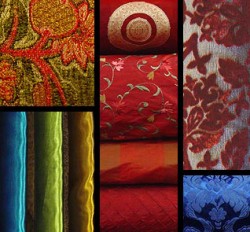 When choosing a fabric and looking at samples in the catalog, you need to remember that a huge canvas will look completely different than a small shred, so frustration may then arise. To avoid this, it is better to use the services of a professional designer or take a whole piece of fabric on bail: many stores can provide such a service. In your room, the fabric may slightly change color (silk is considered especially capricious), it may be too dark or light, etc.
When choosing a fabric and looking at samples in the catalog, you need to remember that a huge canvas will look completely different than a small shred, so frustration may then arise. To avoid this, it is better to use the services of a professional designer or take a whole piece of fabric on bail: many stores can provide such a service. In your room, the fabric may slightly change color (silk is considered especially capricious), it may be too dark or light, etc.
Now consider what type of fabric is suitable in each particular case, depending on a number of factors.
Type of fabric
Now on the shelves there are many synthetic and natural fabrics, and each of them can boast of its advantages. So, natural fabrics look very expensive, rich and noble, even after several years of operation, but they are very expensive. In addition, they are easy to burn out, so it is not recommended to use them in sunny rooms. Curtains made of natural silk will bring to the owners, in addition to their sophisticated appearance, a lot of trouble associated with the fact that it only needs to be cleaned and in no case washed. Meet natural fabrics with special treatment, which gives future curtains greater resistance against burnout, allows you to not sit down when washing, etc.
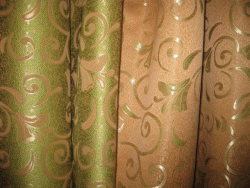 Synthetic fabrics very simple to operate, and their appearance sometimes allows you to confuse them with natural counterparts. But still, the most successful option will be fabrics that are partly made from natural fibers, and partly from synthetic ones. Today, almost all curtain fabrics contain polyester, which gives the product durability and practicality.
Synthetic fabrics very simple to operate, and their appearance sometimes allows you to confuse them with natural counterparts. But still, the most successful option will be fabrics that are partly made from natural fibers, and partly from synthetic ones. Today, almost all curtain fabrics contain polyester, which gives the product durability and practicality.
The most common and popular today are such fabrics:
- 100% polyester or polyester with the addition of cotton - the most practical and wear-resistant option. Such curtains can be washed without fear even in a washing machine, and from frequent washing they do not deform at all, do not sit down, etc .;
- viscose - Another synthetic material that also shows excellent performance. In addition, viscose has excellent flame retardant properties, therefore in the kitchen It will be irreplaceable;
- taffeta - artificial translucent fabric, which, nevertheless, closes the room well from the sun, perfectly manifests itself in washing, looks quite presentable;
- cotton and silk - Excellent natural fabrics that will make the interior cozy and environmentally friendly. But they are very sensitive to sunlight, therefore, even in the room, which faces north, the curtains from these fabrics must be lined;
- linen - A wonderful natural material, which is characterized by excellent appearance, but great demands on care and maintenance.But the addition of synthetic materials to this fabric makes it completely ideal;
 velvet well suited for bedrooms, as it is able to protect very well from the sun;
velvet well suited for bedrooms, as it is able to protect very well from the sun;- tulle it is invariably used for sewing light translucent curtains, which do not move to the side, but rather are a decorative rather than a shading element;
- denim unusual colors fits perfectly into the interior of the children's room due to the appearance and ease of use;
- wool lining on curtains it can make your house warmer, as it will not let in the cold from the street. In summer, such curtains can be replaced with lighter and more transparent.
There are also many other fabrics, but when choosing, pay attention to how soft the material is and how much it will succumb to drapery, so that in the end you get spectacular folds.
Many people decide to use the same textiles for furniture and curtains. In this case, remember that furniture fabric very heavy and for it will need a more powerful and durable curtain rod. Do not forget to also look at the labeling of the fabric for possible use not only for upholstery. If there is only a chair icon on it, then it will be badly draped and it will not be possible to achieve a good aesthetic effect.
Color and fabric pattern
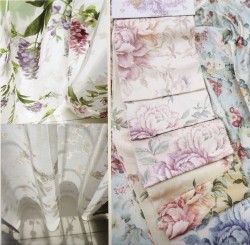 After the issue is resolved with the material, it is the turn of the choice of color and pattern. Here your personal preferences go into battle, taking into account the existing interior of the room. It is important that the curtains, which differ in a considerable area, harmoniously fit into the space and emphasize all the advantages of the room. Often, designers are advised to choose the color of the curtains to match the walls, only a little lighter or darker so that they do not merge. Others say that it’s good to choose the color, come from furniture colors or that subject of textile, decor, etc., which occupies the largest area in the room.
After the issue is resolved with the material, it is the turn of the choice of color and pattern. Here your personal preferences go into battle, taking into account the existing interior of the room. It is important that the curtains, which differ in a considerable area, harmoniously fit into the space and emphasize all the advantages of the room. Often, designers are advised to choose the color of the curtains to match the walls, only a little lighter or darker so that they do not merge. Others say that it’s good to choose the color, come from furniture colors or that subject of textile, decor, etc., which occupies the largest area in the room.
The golden rule when choosing a color and pattern for curtains states that the room should not be a heap of all kinds of ornaments that are difficult to combine with each other. therefore if the walls are plain, then feel free to choose a bright fabric for curtains with an interesting pattern, so that the curtains become a highlight of the interior, and if the wallpaper has some kind of pattern, and even there are some elements with a pattern in the room, then in this case, plain curtains are the best choice. Naturally, if the fabric is used both for curtains and for other textiles in the room (bedspread, pillows, tablecloths, etc.), then you can achieve an excellent effect that will transform any room and make it like a magazine cover.
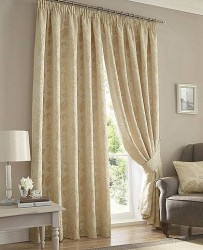 If nevertheless you decide to take fabric for curtains with a pattern, then be extremely careful: if the room already has elements with an ornament, it is necessary that the fabric for the curtains be combined with them and not cause a feeling that the owners lack a sense of taste. In addition, the drawing should be suited to the style of the interior: for a classic interior, sockets, stripes, etc. are suitable, for provence - small flowers. If your window will be decorated with two cloths of fabric: for example, tulle and curtains, or even if it will be present and a lambrequin, then with a picture there should be only one element.
If nevertheless you decide to take fabric for curtains with a pattern, then be extremely careful: if the room already has elements with an ornament, it is necessary that the fabric for the curtains be combined with them and not cause a feeling that the owners lack a sense of taste. In addition, the drawing should be suited to the style of the interior: for a classic interior, sockets, stripes, etc. are suitable, for provence - small flowers. If your window will be decorated with two cloths of fabric: for example, tulle and curtains, or even if it will be present and a lambrequin, then with a picture there should be only one element.
Pay attention to degree of lighting in the roomas well as the size of the room itself. For small rooms, bright fabrics or fabrics with a huge pattern will be inappropriate, which can make a miniature room even smaller. For such spaces, light pastel shades, as well as vertical or horizontal stripes, will be ideal. In huge rooms, the choice of fabric for curtains is not limited to anything: however, if you want to make the room more comfortable, it is better to choose dark saturated shades, but light curtains will look harmonious.
For rooms with not very good natural light curtains of warm shades are suitable: peach, beige, orange, pink, etc. - they are able to give space more light.And green, blue, blue, gray cool the room more, so they will become indispensable where the windows face south, and where it is very hot in summer. For dark rooms, heavy and dense fabrics will be inappropriate, so pay attention to translucent organza, chintz, veil.
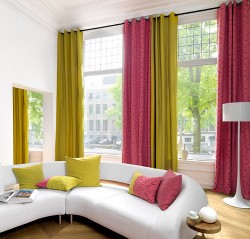 If at the same time fabric is selected for both tulle and drapes, then both materials must be either contrasting or in the same key. Sometimes lambrequins are still used - a part that adorns the top of the curtains and gives them a complete look. Lambrequin will advantageously complement the window in a room with high ceilings and a rather large area. If the ceilings are low, and the room has so little space and light, then it is better to refuse lambrequins and other decorative elements: in this case, the easier the window looks, the better.
If at the same time fabric is selected for both tulle and drapes, then both materials must be either contrasting or in the same key. Sometimes lambrequins are still used - a part that adorns the top of the curtains and gives them a complete look. Lambrequin will advantageously complement the window in a room with high ceilings and a rather large area. If the ceilings are low, and the room has so little space and light, then it is better to refuse lambrequins and other decorative elements: in this case, the easier the window looks, the better.
Curtain fabric is best appreciated not only in the storebut also at home, in natural light. In addition, it is better to analyze how it is perceived at a distance at which households usually look at the curtains. It is important that the fabric that you buy for curtains is cut from one roll: fabrics from different batches may differ slightly from each other, which will be very noticeable on the window.
Fabric for curtains and room
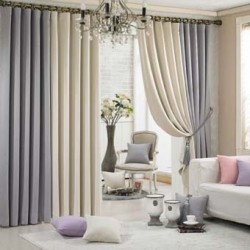 For bedrooms and living rooms it is better to choose a fabric as dense as possible, so that if necessary it could create subdued lighting even during the day when the sun shines brightly. Dense fabrics, in addition, also create additional sound insulation, so they become just the perfect option for the bedroom. You can choose curtains on the lining, which not only makes the dimming more pronounced, but also prevents the burnout of the main fabric. There are three-layer curtains that do not allow even the brightest light from the street - ideal for a bedroom located in a busy area of the city.
For bedrooms and living rooms it is better to choose a fabric as dense as possible, so that if necessary it could create subdued lighting even during the day when the sun shines brightly. Dense fabrics, in addition, also create additional sound insulation, so they become just the perfect option for the bedroom. You can choose curtains on the lining, which not only makes the dimming more pronounced, but also prevents the burnout of the main fabric. There are three-layer curtains that do not allow even the brightest light from the street - ideal for a bedroom located in a busy area of the city.
- For the living room, in principle, any fabric will fit, and the choice of its features depends more on the parameters of the room itself, which were described above. Here fit perfectly both light transparent fabrics and heavier lambrequin versions.
- For a children's room can choose the fabric is brighter, with interesting drawings, fairy-tale characters, etc.
- For kitchen the main thing is that the fabric is easy to clean and does not lose its appearance from numerous washes, so pay attention to viscose, nylon, polyester. Please note that in kitchen curtains there should be few wrinkles, as they accumulate an unpleasant odor and dust. It is even better if the fabric is saturated with special products that protect it from the effects of grease, dirt, and sunlight.
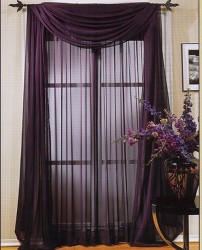 Please note that in some cases it is necessary to provide lining for curtains. It is necessary not only to protect the material from burning out - with its help, the pattern on the curtains, texture are visible much better, and the folds become softer. In addition, sound insulation is enhanced, and for materials such as velvet and silk, lining is a must.
Please note that in some cases it is necessary to provide lining for curtains. It is necessary not only to protect the material from burning out - with its help, the pattern on the curtains, texture are visible much better, and the folds become softer. In addition, sound insulation is enhanced, and for materials such as velvet and silk, lining is a must.
Curtains should harmoniously fit into the existing interior, meet the chosen style. Each direction in interior design is characterized by its own types of curtains: this is in most cases, not taking into account some bold design ideas.
You can sew any type of curtains from fabric: French, Austrian, Roman, Italian, etc. It is important that the selected fabric and curtain model fit in with the interior. So, French curtains perfectly complement the bedroom or living room in a classic style, Roman curtains or tulle - to a high-tech room.
How much fabric do you need?
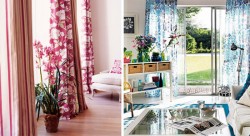 Important from the start take all necessary measurementsto know how much fabric will be needed for the selected curtain model. First you need to measure the length cornice, which is acquired in advance, and then multiply the resulting value by 1.5-3 - the assembly coefficient, which will be different in each case.So, if curtains with magnificent drapery are necessary, then multiply by 2-2.5, for tulle the coefficient reaches 3, and for curtains that will not move, you can choose a value of 1.2-1.5.
Important from the start take all necessary measurementsto know how much fabric will be needed for the selected curtain model. First you need to measure the length cornice, which is acquired in advance, and then multiply the resulting value by 1.5-3 - the assembly coefficient, which will be different in each case.So, if curtains with magnificent drapery are necessary, then multiply by 2-2.5, for tulle the coefficient reaches 3, and for curtains that will not move, you can choose a value of 1.2-1.5.
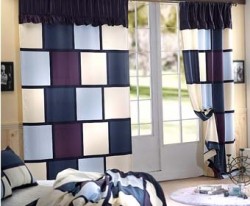 Now for curtain lengths. So, you should measure the estimated length from the cornice to the floor, to windowsill etc. - depending on your own ideas. 15-20 cm is left for the hem in height. Since the width of the panels is rarely more than 1.5 m, you will have to stitch together several segments, so keep in mind that if there is a pattern, it should match, and the fabric should be taken with a margin. To the obtained length of the fabric add the value, which is calculated as follows. The length of the rapport (repeating parts of the figure) is multiplied by the number of paintings that need to be stitched, and one is taken away.
Now for curtain lengths. So, you should measure the estimated length from the cornice to the floor, to windowsill etc. - depending on your own ideas. 15-20 cm is left for the hem in height. Since the width of the panels is rarely more than 1.5 m, you will have to stitch together several segments, so keep in mind that if there is a pattern, it should match, and the fabric should be taken with a margin. To the obtained length of the fabric add the value, which is calculated as follows. The length of the rapport (repeating parts of the figure) is multiplied by the number of paintings that need to be stitched, and one is taken away.
Please note that before cutting and sewing, it is better to wash and iron the fabric: this way you protect yourself from the fact that an already sewn product can shrink or shed.
Finally
The choice of fabric for curtains is a very responsible task, on which the appearance of the finished product and the ease of care for it will depend. That is why it is necessary to approach this issue with all responsibility, repeat all measurements several times and look at the maximum number of possible options in search of the perfect fabric. if you decide to sew together fabrics of different fabrics, then make sure that they do not fade each other during washing and have a similar way of leaving. The tips listed above should help with this difficult choice.

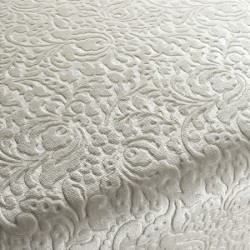










great article! I made curtains from Italian cotton to my country house. Thanks to your advice, a good living room has come out.
At my place the most dirty repair work began, and in order to somehow survive this, I began to engage in the selection of finishes, decor and curtains. The style is chosen, the matter remains with the fabric and price. I’m probably not going to buy in many stores - it's too expensive. It is much cheaper to buy new curtains on Avito from a private person.